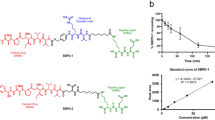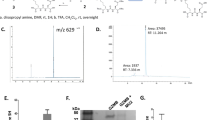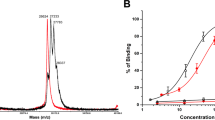Abstract
We have utilized a novel polyethylenimine (PEI)/DNA-βgal vector to investigate the specificity and efficiency of immuno-targeting prostate-specific membrane antigen (PSMA). Coupling of the PSMA-specific monoclonal antibody, J591, to the vector was facilitated via the high-affinity interaction between phenyl(di)boronic acid and salicylhydroxamic acid molecules. Highly efficient gene delivery by this prostate cancer (PCA)-targeted J591/polyethylene glycol (PEG)/PEI/DNA-βgal vector was demonstrated in PSMA-positive cells relative to controls, resulting in significant growth inhibition in vitro when the J591/PEG/PEI/DNA-p53 was used. Competition with free antibody resulted in about 90% reduction in both J591 internalization and βgal gene delivery, indicating specificity for PSMA-positive cells. More importantly, testing the efficiency of the J591/PEG/PEI/DNA-βgal targeting vector in an orthotopic PCA model in nude mice resulted in up to a 20-fold increase in gene delivery over the untargeted vector controls. The in vivo organ distribution profile also revealed βgal expression predominantly in the tumor, which was more than 1 log higher than the next highest level of expression in the lung. Furthermore, with the targeted vector containing the gene for yellow fluorescent protein or biotinylated J591, we further demonstrate in vivo that vector-mediated gene delivery is specific for both tumor cells and tumor-associated neovasculature in PSMA-positive tumors. These results suggest the potential for further optimization of this novel vector in the context of therapeutic gene delivery.
This is a preview of subscription content, access via your institution
Access options
Subscribe to this journal
Receive 12 print issues and online access
$259.00 per year
only $21.58 per issue
Buy this article
- Purchase on Springer Link
- Instant access to full article PDF
Prices may be subject to local taxes which are calculated during checkout









Similar content being viewed by others
References
Verma IM, Somia N . Gene therapy – promises, problems and prospects. Nature 1997; 389: 239–242.
Luo D, Saltzman M . Synthetic DNA delivery systems. Nat Biotech 2000; 18: 33–37.
Luo D . A new solution for improving gene delivery. Trends Biotech 2004; 22: 101–103.
Putnam D, Gentry CA, Pack DW, Langer R . Polymer-based gene delivery with low toxicity by a unique balance of side-chain termini. Proc Natl Acad Sci USA 2001; 98: 1200–1205.
Rochlitz CF . Gene therapy of cancer. Swiss Med Wkly 2001; 131: 4–9.
Brown MD, Schatzlein AG, Uchegbu IF . Gene delivery with synthetic (non viral) carriers – progress and problems. Int J Pharm 2001; 229: 1–21.
Liu F, Huang L . Development of non-viral vectors for systemic gene delivery. J Control Rel 2002; 78: 259–266.
Boussif O, Zanta MA, Behr J-P . Optimized galenics improve in vitro transfer with cationic molecules up to a thousand-fold. Gene Therapy 1996; 3: 1074–1080.
Abdallah B, Hassan A, Benoist G, Goula D, Behr JP, Demeneix BA . A powerful non viral vector for in vivo gene transfer into the adult mammalian brain. Hum Gene Ther 1996; 20: 1947–1954.
Coll JL, Chollet P, Brambilla E, Desplanques D, Behr JP, Favrot M . In vivo delivery to tumors of DNA complexed with linear polyethylenimine. Hum Gene Ther 1999; 10: 1659–1666.
Rubanyi GM . The future of human gene therapy. Mol Aspects Med 2001; 89: 21–39.
Silver DA, Pellicer I, Fair WR, Heston WD, Cordon-Cardo C . Prostate specific membrane antigen expression in normal and malignant human tissues. Clin Can Res 1997; 3: 81–85.
O'keefe DS, Uchida A, Bacich DJ, Watt FB, Martorana A, Molloy PL et al. Prostate-specific suicide gene therapy using the prostate-specific membrane antigen promoter and enhancer. Prostate 2000; 45: 149–157.
Horoszewicz JS, Kawinski E, Murphy GP . Monoclonal antibodies to a new antigenic marker in epithelial prostate cells and serum of prostatic cancer patients. Anticancer Res 1987; 7: 927–936.
Lapidus RG, Tiffany CW, Isaacs JT, Slusher BS . Prostate specific membrane antigen enzyme activity is elevated in prostate cancer cells. Prostate 2000; 45: 350–354.
Wright GL, Haley C, Beckett ML, Schellhammer PF . Expression of prostate specific membrane antigen in normal, benign, and malignant prostate tissues. Urol Oncol 1995; 1: 18–28.
Noss KR, Wolfe SA, Grimes SR . Up-regulation of prostate specific membrane antigen/folate hydrolase transcription by an enhancer. Gene 2002; 285: 247–256.
Chang SS, Reuter VF, Heston WD, Bander NH, Grauer LS, Gaudin PB . Five different anti-prostate-specific membrane antigen (PSMA) antibodies confirm PSMA expression in tumor-associated neovasculature. Cancer Res 1999; 59: 3192–3198.
Liu H, Rajasekaran AK, Moy P, Xia Y, Kim S, Navarro V et al. Constitutive and antibody-induced internalization of prostate-specific membrane antigen. Cancer Res 1998; 58: 4055–4060.
Wiley JP, Hughes KA, Kaiser RJ, Kesicki EA, Lund KP, Stolowitz ML . Phenylboronic acid–salicylhydroxamic acid bioconjugates. 2. Polyvalent immobilization of protein ligands for affinity chromatography. Bioconjugate Chem 2001; 12: 240–250.
Stolowitz ML, Ahlem C, Hughes KA, Kaiser RJ, Kesicki EA, Li G et al. Phenylboronic acid–salicylhydroxamic acid bioconjugates. 1. A novel boronic acid complex for protein immobilization. Bioconjugate Chem 2001; 12: 229–239.
Moffatt S, Wiehle S, Cristiano RJ . Tumor-specific gene delivery mediated by a novel peptide-polyethylenimine–DNA polyplex targeting aminopeptidase N (CD13). Hum Gene Ther 2005; 16: 57–67.
Fronsdal K, Engedal N, Saatcioglu F . Eficient DNA-mediated gene transfer into prostate cancer cell line LnCap. Prostate 2000; 43: 111–117.
Thurman SA, Ramakrishna NR, DeWeese TL . Radiation therapy for the treatment of locally advanced and metastatic prostate cancer. Hematol Oncol Clin N Am 2001; 15: 423–443.
Letsch M, Schally AV, Szepeshazi K, Halmos G, Nagy A . Effective treatment of experimental androgen sensitive and androgen independent intra-osseous prostate cancer with targeted cytotoxic somatostatin analogue AN-238. J Urol 2004; 171: 911–915.
Gosselin MA, Guo W, Lee RJ . Efficient gene transfer using reversibly cross-linked low molecular weight polyethylenimine. Bioconjugate Chem 2001; 12: 989–994.
Balasubramaniam RP, Bennett MJ, Aberle AM, Malone JG, Nantz MH, Malone RW . Structural and functional analysis of cationic transfection lipids: the hydrophobic domain. Gene Therapy 1996; 3: 163–172.
Zou Y, Zong G, Ling YH, Perez-Soler R . Development of cationic liposome formulations for intratracheal gene therapy of early lung cancer. Cancer Gene Ther 2000; 7: 683–696.
Solodin I, Brown CS, Bruno MS, Chow CY, Jang EH, Debs R et al. A novel series of amphilic imidazolinium compounds for in vitro and in vivo delivery. Biochemistry 1995; 34: 13537–13544.
Lee ER, Marshall J, Siegel CS, Jiang C, Yew NS, Nichols MR et al. Detailed analysis of structures and formulations of cationic lipids for efficient gene transfer to the lung. Hum Gene Ther 1996; 7: 1701–1717.
Gorman CM, Aikawa M, Fox B, Fox E, Lapuz C, Michaud B et al. Efficient in vivo delivery of DNA to pulmonary cells using the novel lipid EDMPC. Gene Therapy 1997; 4: 983–992.
Coll J, Negoescu A, Louis N, Sachs L, Tenaud C, Girardot V et al. Antitumor activity of bax and p53 naked gene transfer in lung cancer: in vitro and in vivo analysis. Hum Gene Ther 1998; 9: 2063–2074.
Coll JL, Chollet P, Brambilla E, Desplanques D, Behr JP, Favrot M et al. In vivo delivery to tumors of DNA complexed with linear polythylenimine. Hum Gene Ther 1999; 10: 1659–1666.
Smrekar B, Wightman L, Wolschek MF, Lichtenberger C, Ruzicka R, Ogris M et al. Tissue-dependent factors affect gene delivery to tumors in vivo. Gene Therapy 2003; 10: 1079–1088.
Verbaan FJ, Oussoren C, van Dam IM, Takakura Y, Hashida M, Crommelin DJ et al. The fate of poly(2-dimethyl amino ethyl)methacrylate-based polyplexes after intravenous administration. Int J Pharm 2001; 214: 99–101.
Brown LF, Guidi AJ, Tognazzi K, Dvorak HF . Vascular permeability factor/vascular endothelial growth factor and vascular stroma formation in neoplasia. Insights from in situ hybridization studies. J Histochem Cytochem 1998; 46: 569–575.
Skobe M, Rockwell P, Goldstein N, Vosseler S, Fusenig NE . Halting angiogenesis suppresses carcinoma cell invasion. Nat Med 1997; 3: 1222–1227.
Gasparini G, Brooks PC, Biganzoli E, Vermeulen PB, Bonoldi E, Dirix LY et al. Vascular integrin αvβ3: a new prognostic indicator in breast cancer. Clin Cancer Res 1998; 4: 2625–2634.
Wright Jr GL, Grob BM, Haley C, Grossman K, Newhall K, Petrylak D et al. Upregulation of prostate-specific membrane antigen after androgen-deprivation therapy. Urology 1996; 48: 326–334.
Author information
Authors and Affiliations
Corresponding author
Rights and permissions
About this article
Cite this article
Moffatt, S., Papasakelariou, C., Wiehle, S. et al. Successful in vivo tumor targeting of prostate-specific membrane antigen with a highly efficient J591/PEI/DNA molecular conjugate. Gene Ther 13, 761–772 (2006). https://doi.org/10.1038/sj.gt.3302721
Received:
Revised:
Accepted:
Published:
Issue Date:
DOI: https://doi.org/10.1038/sj.gt.3302721
Keywords
This article is cited by
-
Anti-tumor effects of a recombinant anti-prostate specific membrane antigen immunotoxin against prostate cancer cells
BMC Urology (2017)
-
Invading target cells: multifunctional polymer conjugates as therapeutic nucleic acid carriers
Frontiers of Chemical Science and Engineering (2011)



